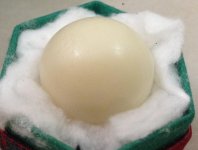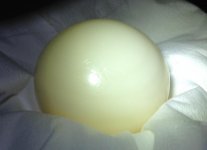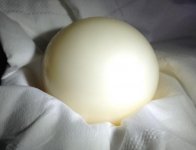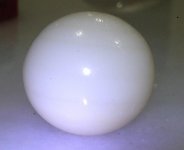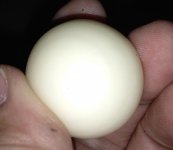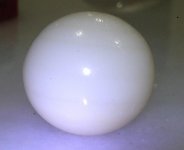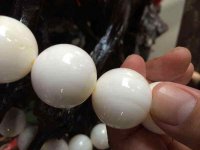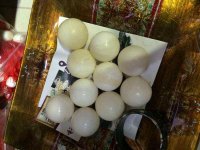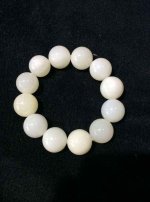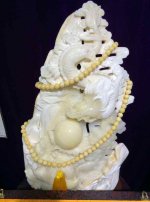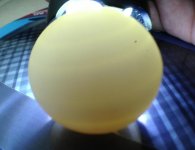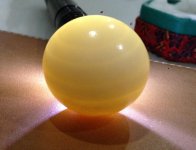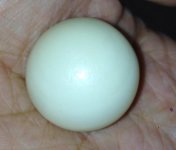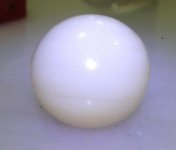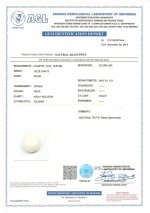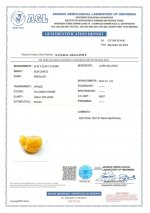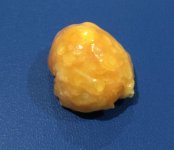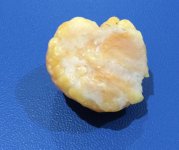The putative Nautilus pearls in this thread could never become ammolite, which is petrified nacre. That said, just think if a nacreous pearl could be transformed as was this hefty chunk of ammonite aperture!
A rare specimen, 100% gemstone:
View attachment 26498
Ammolite is most typically a two-dimensional gem, united with its matrix of petrified sediment. A loose pearl would first have needed to survive the decomposition of the mollusk to be enveloped in the protective sediment, and then only the outermost layers of aragonite would be preserved. The ammolite pearl, if it existed, would be lost in the midst of the rock that forms the interior of a
potentially priceless ammonite fossil.
But it would be beautiful in its maker's eyes.
Update: I visited a lease on the Bear Paw Shale in Southern Alberta last summer. This is within what is commonly known as the K-zone. A massive area, where shells have been crushed and/or flattened by subsequent layers of overburden. I discovered three specimens which are important to this discussion. Specimen 1, is an ammonite with considerable shell damage from a predator attack. Clearly, these are mainly blister type pearls, but several present as singular loose pearls. Although the pearls themselves have since been replaced, there is an a convex aragonitic surface with andate margins. I've also attached images of replaced pearls, selected for their immediate proximity to the aragonitic surface of the shell itself.
These were found at the waterline of the river. The ammonite had rolled downhill, smashing to bits yet the debris field remained within a small range. In retrospect, reconstruction proved more ideal than destruction. After all there was no need to smash otherwise intact fossils.
Upon cursory examination, it's apparent ammonites are much larger than the pearl oysters utilized in today's aquaculture. Specimens of 10-20x larger are typical and as such, the size of pearls is directly proportional. Specimen 2 contained several spherical concretions, consistent with Steve's speculation. Likewise, Specimen 3 demonstrates a single concretion.
Alberta has very strict regulations governing fossils. Having unearthed these samples at a shell agreement site, we were duly bound to report and apply to the Royal Tyrell Museum for a disposition. Needless to say, the senior paleontologists would deny the application.
The email read:
Dave
Thank you for your email. Sorry for the delay in getting back to you but I wanted to check a few things before responding. Based on the information provided in your email and what appears to be an overall absence of fossil pearls in our collection, it is unlikely that Disposition would be issued for the fossils in question.
Given your scientific interest in the fossils, the fossils can be deposited here and given Royal Tyrrell Museum (RTMP) accession numbers that can then be used by you and your team when publishing your results. I recommend contacting our Collections Manager, Brandon Strilisky (cc’d on this email) to discuss the details for dropping the fossil off, getting accession numbers and details for moving forward with the scientific study of the fossil. It is our policy to include all relevant collector and/or finder information in our Collections database.
It may also be useful for you or one of your research team members to visit our collections to see if there are pearls associated with any specimens already catalogued here. It is possible that we have pearls in our collection but they haven’t been recognized, yet.
Please let me know if you have any questions.
Dan
Dan Spivak
Head, Resource Management Program
Royal Tyrrell Museum of Palaeontology
T: 403-823-7707 | F: 403-823-7131
Box 7500, Drumheller, Alberta T0J 0Y0 Canada
www.tyrrellmuseum.com
Although they'll retain the lot, I'm the namesake of the discovery by record. Joined by the invitation to collaborate with museum identifying pearls which may already be in the collection. This is a terrific opportunity, especially in light of Covid-19 and it's imposed austerity measures.
For the moment it's prudent to remain skeptical, despite the appearance of one and two adding up. These specimens need closer scrutiny on many levels to be certified.
I've been invited back to the shell agreement next season. There will two challenges. The first, determining a rate of incidence. The second, discovering a true ammolite pearl. That being the discovery of an aragonitic concretion by the reformation of it's own natural structure. At that time, I'm also planning to visit the RTM collection to examine "Blue Zone" fossils. This is very important because this is the zone which produces entire, high quality specimens. I doubt I'll be allowed destructive testing, so it will be incumbent upon me to be highly objective while examining the external integrity of specimens.

